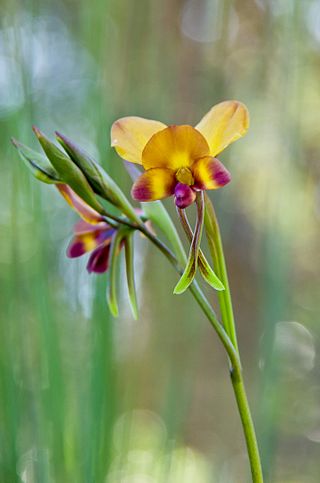
Diuris corymbosa, commonly called common donkey orchid or wallflower orchid, is a species of orchid which is endemic to the south-west of Western Australia. It is similar to the purple pansy orchid but its flowers are yellow rather than purple or mauve and it flowers earlier in the year. It also resembles the winter donkey orchid but flowers later than that species. It is one of the most common orchid species in the Perth area, often forms extensive colonies and usually has numerous flowers on the one spike.

Diuris laxiflora, commonly known as bee orchid, is a species of orchid which is endemic to the southwest of Western Australia. It has two to five narrowly linear leaves and up to six yellow flowers with brown markings. It is a small orchid, common within its range and about half the size of the common donkey orchid, Diuris corymbosa.

Diuris punctata, commonly known as the purple donkey orchid is a species of orchid which is endemic to south-eastern continental Australia. It has two grass-like leaves and up to ten purple or mauve flowers, often with darker, sometimes yellow marks. A yellow form from near Guyra is probably now extinct.
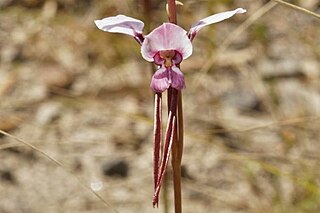
Diuris arenaria, commonly known as the Tomaree donkey orchid or sand doubletail is a species of orchid which is endemic to a very small area of New South Wales. It has two grass-like leaves and up to nine mauve or light purple and white flowers. It has a very limited distribution near Newcastle.

Diuris oporina, commonly called the autumn donkey orchid or northern white donkeys tails is a species of orchid that is endemic to Queensland. It has a single tapering, linear leaf at its base and up to ten white flowers with mauve to purple markings. It grows in the drier parts of the tablelands in Far North Queensland.

Diuris picta, commonly called the granite bee orchid or granite donkey orchid, is a species of orchid which is endemic to the south-west of Western Australia. It has between three and five leaves at its base and up to eight creamy-white to yellow flowers with brownish purple markings. It grows on granite outcrops between Menzies and Lake King.

Diuris pulchella, commonly called the beautiful donkey orchid is a species of orchid that is endemic to the south-eastern part of the south-west of Western Australia. It has two or three leaves at its base and up to five bright yellow and mauve flowers described as "exquisite", "spectacular" and "attractive". It grows in shallow soil on granite outcrops near Esperance.
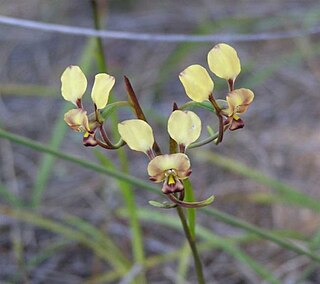
Diuris recurva, commonly called the mini donkey orchid is a species of orchid that is endemic to the south-west of Western Australia. It has one or two leaves at its base, up to six small pale yellow and brownish flowers and grows in winter-wet places between Badgingarra and Kalbarri.
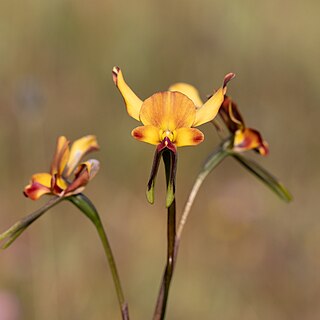
Diuris brachyscapa, commonly known as western wheatbelt donkey orchid, is a species of orchid that is endemic to the south-west of Western Australia. It has two or three linear leaves and a flowering stem with up to four pale yellow flowers with brown markings.

Diuris hazeliae, commonly known as yellow granite donkey orchid, is a species of orchid that is endemic to the south-west of Western Australia. It has between two and four linear leaves and up to six bright yellow and reddish-brown flowers.

Diuris leopardina is a species of orchid that is endemic to south-eastern continental Australia. It has between two or three grass-like leaves of different lengths, and a flowering stem with up to five pale yellow to butter yellow flowers with reddish brown or purple marks and patterns, and leopard-like spots on the back.
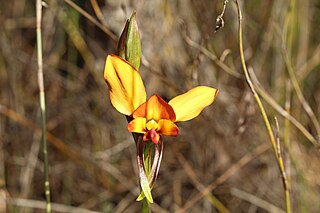
Diuris littoralis, commonly known as Green Range donkey orchid, is a species of orchid that is endemic to the south-west of Western Australia. It has two or three linear leaves and up to six yellow, brown and mauve flowers from late July to early September.

Diuris oraria, commonly known as northern coastal donkey orchid, is a species of orchid that is endemic to a small area of the north coast of Western Australia. It has two or three linear to lance-shaped leaves and up to four yellow flowers with reddish-brown and purple markings.
Diuris pallescens, commonly known as pale donkey orchid, is a species of orchid that is endemic to the south-west of Western Australia. It has two or three linear to lance-shaped leaves and up to seven pale yellow flowers with light brown to reddish-brown markings.
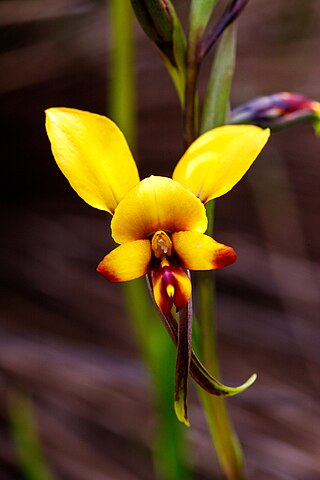
Diuris perialla, commonly known as early donkey orchid, is a species of orchid that is endemic to the south-west of Western Australia. It has two or three linear to lance-shaped leaves and up to four yellow flowers with reddish markings.

Diuris porphyrochila, commonly known as Yalgorup donkey orchid, is a species of orchid that is endemic to the south-west of Western Australia. It has two or three linear to lance-shaped leaves and a flowering stem with up to eight yellow flowers with brown to reddish-brown and purple markings.
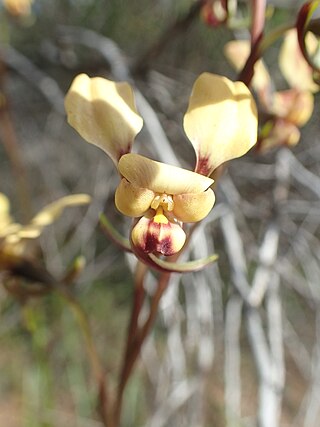
Diuris refracta, commonly known as dainty donkey orchid, is a species of orchid that is endemic to the south-west of Western Australia. It has two or three linear to lance-shaped leaves and up to six yellow flowers with reddish markings.

Diuris suffusa, commonly known as mottled donkey orchid, is a species of orchid that is endemic to the south-west of Western Australia. It has two or three linear to lance-shaped leaves and up to seven cream-coloured to creamy-yellow flowers with light brown to reddish-brown markings.
Diuris tinctoria, commonly known as sandplain donkey orchid, is a species of orchid that is endemic to the south-west of Western Australia. It has two or three linear to lance-shaped leaves and two to five pale yellow flowers suffused with light brown.

Diuris tinkeri, commonly known as Arrowsmith donkey orchid, is a species of orchid that is endemic to the south-west of Western Australia. It has two or three linear to lance-shaped leaves and up to seven yellow flowers suffused with reddish-purple to purple.


















